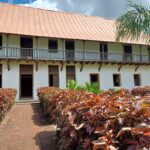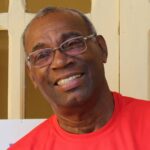Happy Days in Havana, Cuba
My family comes from Havana, so I know it very well. I spent a lot of my childhood there and a large part of it feels like home. It is charming and a classic capital city, stereotypically busy and bustling with motorbikes, the most common form of available transport for locals. It is not unusual to see someone carrying a large shopping bag balanced on top of their knees and a highly coloured iced cake in one hand, whilst the motorbike driver orienteers his way round potholes, people and vintage Pontiacs. Classic cars are everywhere in Cuba, and I can recall one of my taxi drivers, Adrian, proudly announced that his beautifully restored bright red Chevrolet was coming up for 58 years old. The large sound system booming reggaeton from its speakers was clearly from a more contemporary era – but contrasts like this are very common in Cuba and only attribute to its enchanting nature.
To be honest, I would say that the “No.1 thing to do” in Havana is get yourself lost in the streets of Habana Vieja, the old town. Being a city with a tumultuous past of colonisation, it has a melting pot of influences throughout, with so many different styles of architecture and backgrounds of people. The squares and streets of Havana are a feast for the eyes with friendly, outgoing locals (keep your wits about you but also do not feel too threatened by how friendly they actually are). My favourite thing about walking around the city is the expanse of colour, from the classic Chevrolets that capture everyone’s attention and hearts to clothing of people in the streets and the very buildings themselves. Hues of green, pink, blue, yellow, red pour down every street. I managed to travel to Cuba in February 2021 after 7 years of not being able to and what really took my breath away was how vibrant it is, in colour and in soul.
Walking along the Malecón – the main promenade along the sea on the North side of Havana – you will see all walks of life. This is a real hub of the city for people to congregate, celebrate and simply hang out. It is a very picturesque area, with extended rows of fishermen casting their lines into the water and children flinging themselves into the sea off the rocks. You also often see pride filled daughters celebrating their Quinceañera (15th birthday celebrations) with photoshoots in their bright, buoyant gowns. I highly recommend a leisurely walk along here, possibly followed by a drink or light meal at the brand-new Hotel Paseo del Prado, which has a roof top bar overlooking the west end of the Malecón and the buildings of Habana Vieja, perfect if you can time it with watching the sunset over the sea.
For places to visit, I would recommend the Havana Club Museum, which offers a history lesson around the big, beautiful colonial style building in the origins of making rum, and what makes Havana Club so special, followed by an optional rum tasting in their very traditional Cuban bar.
Then there is the Museo de los Orishas where you can have a short guided tour describing Santería and its roots in Yoruba. The guide goes through some (not all) of the deities of this religion and how they are also represented in Catholicism. When I last visited, they were unable to offer tours in English, so this is something to check before you visit. They also hold traditional rumba performances here from time to time which are well worth looking into.
We then have the Museo de Bellas Artes, an art gallery featuring criminally underrepresented Cuban art. There are four floors to wander through, ranging from classic/historic art at the top floor (reminiscent of renaissance and baroque eras), more recent expressionism and cubism on floor 3, and finally with contemporary styles on the 2nd floor. They sometimes feature work by students in local elementary, high and higher education schools, and you can see examples of surreal, experimental and pop art which all have their different perceptions of modern life in Cuba and the rest of the world. Of course, all of this work is by the hand of exclusively Cuban artists, allowing you to delve further into the island’s psyche than you might have been able to before. Usually, the current guest artist installation takes residence on the ground floor. When last I visited, there was an exhibition by artist Kcho, who has for 25 years created commentary in art on Cuba’s socio-political climate. It was an incredibly striking and thought-provoking exhibition with works and installations showing representations of Cubans fleeing the country during the Special Period on rafts and ‘boats’, a term I use loosely, as these were made out of whatever those trying to leave the country could get their hands on. Kcho creates exhibitions and works designed to educate and provoke, and his work is definitely worth researching if you are an art fanatic.
The iconic Hotel Nacional is a must-see when visiting Havana. The breath-taking grandeur of its interior is still impressive. It is the go-to hotel for VIPs visiting the country, with the hall of fame where you can walk a history hall of the most famous people that have stayed or visited in the hotel. This is clearly something that the directors of the hotel are very proud to maintain. Walking out into the large hotel garden, you will usually find a trio or quartet of Soneros playing live music and unofficially inviting you to lounge and enjoy a refreshing cocktail. There are gardens swings that you can gently rock on while overlooking the action of the Malecón, with the shimmer of the waves and the barrages of beautiful classic cars that parade the main road, mojito in hand and classic son music in your ears.
Havana in the early to mid-20th century was a party town for foreign nationals, especially Hollywood and music stars from the US. It was easily accessible, being so close to Florida just 90 miles over the Gulf of Mexico. This culture has continued well into the lifestyle in Havana today and is alive with clubs, bars and live music everywhere you go. In Cuba, you cannot play music (or busk) in the street if you did not study it, so the music you hear in Cuba is unique as everyone you will hear is a trained musician who has dedicated their life to the art. It is common to see impromptu dance performances to accompany the buskers, and you can easily expect an extended hand inviting you to showcase your moves in the middle of the square, too. The people of Havana are excited about not only sharing their beautiful culture, but encouraging people to let their hair down and liberate themselves from the self-imposed confines we are used to in western culture. The people of Havana do not care if you ‘can’t dance’, ‘can’t sing’, whatever! It is the smiles on the faces you see that serve a constant reminder of this, and naturally a few sips of Havana Club helps to alleviate a few of these inhibitions, too.
Havana is the epicentre of Cuban culture. It allows you to experience glimpses into different aspects of those which make up Cuban life and history. You can experience this from your local guest house or homestay, or you can do this from the heights of your 5* hotel. You can stop and be invited to play a game of dominos with the viejos (the highest of honours), and you can salsa your way around the cars, motorbikes and cyclists trying to cross the roads. You can take the city in at your own leisure or let the life of the city take you on a whirlwind tour. You can dance, you can sing, learn, listen, smile and cry between the streets of Havana, and may find after all of it that you have learned more than you ever anticipated about Cuba and yourself.
For details of Spanish language and dance courses in Havana, please click on this link to our website.

















